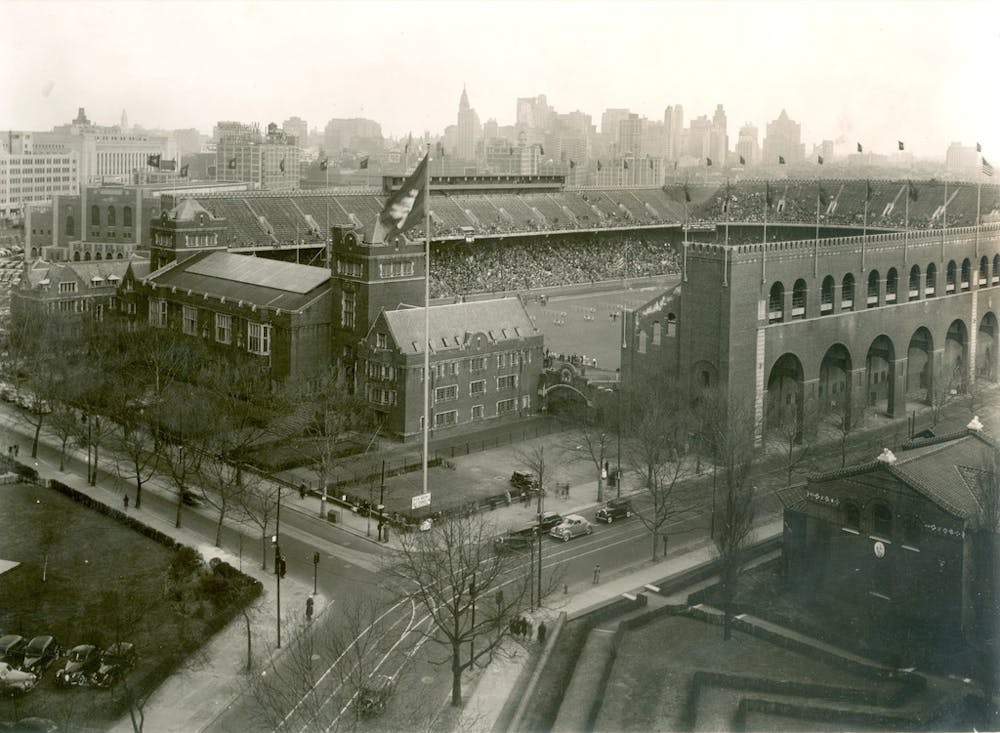When Franklin Field was built in 1895, Grover Cleveland was President, Penn football was in the midst of a 26-game winning streak, and The Daily Pennsylvanian was just 10 years old. In the 126 years since, the oldest currently operating stadium in college football has hosted many historic events.
Here are the top five:
The first Penn Relays: 1895
The inception of the Penn Relays was the reason that Franklin Field was built in the first place. At that time, what is now a full-fledged stadium was very much just a field, although 5,000 fans were in attendance for the races.
The event included high school, prep school, and college races, with Harvard claiming the first Penn Relays championship race in the 4x400-meter relay. In addition to Harvard and Penn, eight schools from Pennsylvania, New York, and New Jersey were among the collegiate competitors.
The very next year, the number of colleges to enter the event quadrupled. The Penn Relays has been held every year since its first running up until its recent cancellation due to the coronavirus.
Spanish Flu football game: 1918
A different pandemic swept the nation in 1918, although sporting events were not canceled on the scale that they have been this year. In late October, Penn’s football team played against the Navy Yard Marines in an empty Franklin Field to prevent the spread of the Spanish Flu.
RELATED:
125 years of Franklin Field: The history of the oldest college stadium in the country
Throwback to the Eagles' last NFL Championship win, 57 years ago
With many leagues now considering moving forward without fans in attendance, this game was an early example of the risks that still remain even without spectators. Penn’s head coach Bob Folwell was hospitalized due to the virus and Penn’s roster was limited to just 22 healthy players.
The Quakers were defeated by the Philadelphia Naval Yard team 7-0 and would go on to finish 5-3 on the season.
Thanksgiving Day Penn-Cornell game: 1931
Franklin Field was the site of both the first radio and television broadcasts of a football game. The stadium led the nation in attendance for football in the 1930s and 1940s, including the Thanksgiving Day game between Penn and Cornell in 1931 which was played in front of 70,000 fans.
Fans sat in temporary stands constructed where the track now lies. In the late 1940s, Penn-Cornell games were reported to attract even larger crowds, sometimes topping over 80,000 fans. The 1931 game was also broadcast on national radio and became the subject of a front-page story in The Philadelphia Inquirer.

Eagles vs. Packers NFL Championship: 1960
From 1958 through 1970, Franklin Field was home to the Philadelphia Eagles. The stadium provided nearly double the seating capacity of their previous home at Connie Mack Stadium (also known as Shibe Park) in North Philadelphia.
In 1960, the Eagles faced a heavily favored, Vince Lombardi-led Packers team in the 28th NFL title game. The Eagles pulled off the upset with a 17-13 win, finishing the season 10-2 and handing Lombardi what would be his only playoff defeat.
The Eagles had won the 1948 championship at Shibe Park and their 1960 victory would be the only other NFL championship played in Philadelphia to this day.
Liberty Bell Track and Field Classic: 1980
In 1980, the United States, along with 25 other countries, boycotted the Summer Olympics in Moscow because of the Soviet Invasion of Afghanistan. Penn hosted a two-day track and field event for athletes from these nations, who competed in front of 20,000 spectators.
The event was held three days prior to the opening of the Moscow Olympics and athletes in the 110m and 400m hurdles ran times better than those set at the actual Olympic games. Other than the Penn Relays, this was the largest track and field event held at Franklin Field in terms of the number of fans in attendance.









